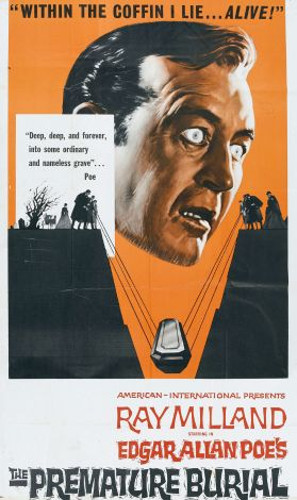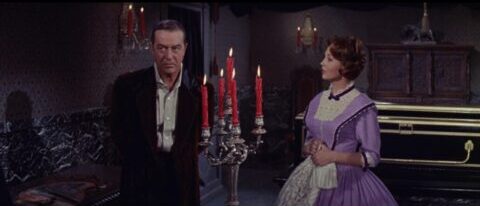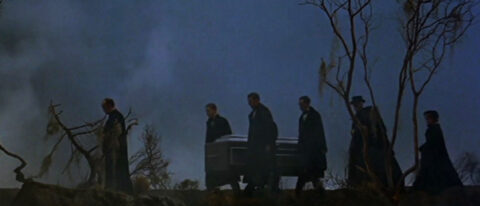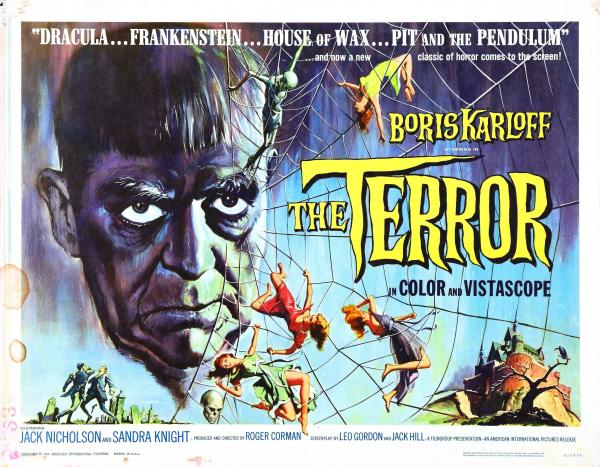The Premature Burial (1961)
Directed by: Roger Corman
Written by: Charles Beaumont, Edgar Allan Poe, Ray Russell
Starring: Hazel Court, Heather Angel, Ray Milland, Richard Ney
USA
AVAILABLE ON BLU-RAY Region A only, DVD and DIGITAL
RUNNING TIME: 81 mins
REVIEWED BY: Dr Lenera

Guy Carrell is a British aristocrat who’s consumed with the fear of being buried alive. He thinks that he suffers from the same catalepsy which he believes struck his father, causing him to be placed in his tomb while not actually dead. As a young boy, he heard his father scream from his tomb after being interred, though his sister Kate thinks that it’s all his mind and is trying to steer her brother back to some kind of normality. Into this morbid household comes Guy’s fiancee, Emily Gault. Guy tries to put her off marrying him, but with no luck, so the marriage goes ahead. However, after collapsing just after the wedding ceremony, Guy becomes even more obsessed, spending most of his time in an elaborate vault, equipped with several safeguards in case of his premature burial, including a poisonous elixir to be used as a last resort. Emily and his colleague, Miles Archer, become very concerned….

Being buried alive is most definitely a terrifying thought, which is obviously why such an act is so often featured in films. Some of my favourites include the ending of The Vanishing [the original version of course], the beginning of Short Night Of Glass Dolls, and that scene in City Of The Living Dead where the hero is using a pickaxe to try to smash into the coffin where the heroine has been put in and misses smashing her face in by a few centimetres. The idea was used by Edgar Allan Poe in five separate stories. The eight films directed by Roger Corman from 1960 to 1964 remain the cinema’s most enduring adaptations of the great writer’s work. Back in 2008 this website’s Bat and I went through the six-film Corman/Poe boxset reviewing all the movies contained therein, but two films in the series were missing. One was The Masque Of The Red Death, generally considered to be the artistic peak of the franchise, though the review of it on HCF isn’t very positive so, even after all this time, I may still exercise a critic’s prerogative and do an alternate review. The other was The Premature Burial, which some don’t even consider to be part of the series at all. I recall it being on TV back in the good old days when vintage horror was frequently shown, often in double bills, but, in thinking of something to review during a break in screeners, I suddenly realised that I’d never ever seen it. And not just that, but that I’d owned it for some time on DVD in an eight-film Roger Corman set! It’s generally regarded as one of the weaker Corman/Poes, and is probably the least popular because it doesn’t feature Vincent Price. And also maybe because it’s the gloomiest entry. It doesn’t quite catch fire the way that the others do, but it still has that terrific atmosphere and feel which seems to evoke Poe so well, and Ray Milland, while giving a very different performance to what Price would have given, is very good as long as you can get that incredible voice of Price’s out of your head.
Poe’s 1844 story is typically doom laden and tortured, but gives its protagonist, who as usual narrates, a happy ending. He’s terribly fearful of being buried alive, orders his friends not to bury him should be collapse, refuses to leave his home, and builds an elaborate tomb with equipment allowing him to signal for help in case he should awaken after “death”. But, unlike most Poe main characters, he’s cured of his malady. Poe must have been feeling unusually positive when he wrote it. While the tale has inspired many variations and been adapted as portions of portmanteau films and TV episodes, Corman’s version is the only proper movie version. House Of Usher and The Pit And The Pendulum had been huge hits for American International Pictures, but Corman became engaged in a minor dispute with studio head Samuel Z. Arkoff over money, so decided to make The Premature Burial elsewhere. Price was under an exclusive contract with AIP, so Corman couldn’t have him. He was, though, able to get financing from Pathe Labs which wanted to go into distribution. However, when Arkoff learned of this, he visited the owner of Pathe Labs. Arkoff felt that Pathe was stepping into AIP’s business, but the Pathe boss stood his ground until Arkoff pulled out his trump card; American International was one of Pathe Labs’ largest customers and if it was going into competition with AIP, all of AIP’s lab work would be pulled. Pathe sold the production to AIP before principal photography began. This ended up being advantageous seeing as Corman could reuse sets from the previous two films, but the result performed just decently rather than very well, causing Corman to make the next film in the series different. The original UK cinema version was cut by the seemingly ‘even more squeamish than normal’ BBFC to remove shots of maggots being poured from a cup and a body being covered with earth.
Oh how magical the opening is, the first shot being a pan across some of a particularly glorious foggy graveyard set! The forest that’s behind it is even more gorgeous if you love this sort of thing; yes, it never looks real, but it does have both a strong visual and strong psychological effect, partly because, I think, the trees all look dead. It’s Gothic horror heaven, the most beautiful of Corman’s forest sets – or maybe re-dressings of the same forest set. A group of people are watching two gravediggers remove the earth over the top of a grave and force open the lid. As the lid swings back, we can see blood on the interior, indicative of the person inside having tried to claw their way out, then we cut to a screaming face, the kind of shock cut that probably won’t have viewers jumping now like it would have done in 1961 but may make them feel a bit queasy because of the very concept which really is horrible. A carriage traveling through the expressionistic wood arrives at the Carrell household, but its passenger, Emily, isn’t made to feel very welcome. “Guy does not wish to see you” says his slightly intimidating sister Kate, while her dear fiancee himself, first shown putting the final touches on a hideous portrait which was probably done by the same person who did all the Ushers judging by the style, tells her to “please go away and forget you ever met me”. She’s insistent, so he takes her down into the family crypt where lie buried all his ancestors [if you haven’t guessed already, screenwriters Charles Beaumont and Ray Russell riff on House Of Usher quite a bit] who all died “violent, terrible deaths”, including his father who was buried alive. But Emily is not to be put off.

The wedding goes ahead, but Guy soon spends nearly all his time building and living in this elaborate tomb full of escape routes. Worse than that, Guy tells Emily not to bring any flowers into the house. He’s increasingly gruff and private, but she loves him. It’s mostly fairly sombre, with none of the little touches of often sly humour that peppered House Of Usher and The Pit And The Pendulum; even a pair of potentially comical gravediggers, one of them played the cult legend that is Dick Miller which automatically raises the film up a few notches, don’t provide the laughs that we expect. The emphasis is strictly on the three main characters; Guy, Emily and Kate, the latter being someone that we don’t really trust. Actually, that should that be four, the fourth being Miles whose visits to the house seem to be more because of Emily than Guy. Miles is working on finding a way to revive dead animals, and you’d expect this to play an important part later, but it’s thrown aside. Yet it’s the bits of unpredictability in the story that make it work despite it being filled with cliches. Not paying any attention to the time, on this first viewing, the film to me seemed to end at least ten minutes before it actually did, and it actually would have been a most appropriate, if downbeat, finish. But things then carry on. The plot that’s revealed has its oft-used elements but contains one real surprise, Beaumont and Russell having fed us a red herring before genuinely startling us. Sometimes I reveal all [with of course a spoiler warning] and sometimes I don’t, but I’ll leave this twist for the reader to discover if he or she hasn’t seen this film, partly because it transforms what has been up to then a solid but generally average work into something more interesting. We don’t get a burning house with those oft-repeated shots in it either.
This has perhaps the best of all those dream sequences in these films that exist more to pad out the running time. As the usual coloured filters take over, for several minutes we really are given a nightmare as Guy dreams that none of his escape devices work. Elsewhere, Corman relies a bit of more on shock cuts than usual, and even riffs on Poe’s “The Black Cat” with a sequence involving a cat’s meow coming from behind a wall, a tale that he’d adapt soon after in Tales Of Terror. Beaumont and Russell do put in enough scenes just between the couple so that we understand the dynamic, though we don’t care quite enough as we should. One reason for this is that Emily’s a bit of a pushover even by 1961 standards; how the hell does she put up with this guy for more than a few weeks? The other is that Guy needed to be just a little bit more sympathetic, something that I think can be put down more to the writing than Milland, whose approach takes a bit of getting used to but is rewarding to observe. Price was brilliant at expressing a tortured soul in extravagantly theatrical terms; Milland does it in a more realistic, clinical fashion. He projects a more clinical obsessive-compulsive disorder yet is also able to contort his face to look more sinister when he needs to. I recall reading a review of this film some time back which interpreted the character’s aloofness, even coldness at many times, as Milland phoning in the part, but I don’t think that’s the case; he’s just approaching the role from a perhaps less entertaining but probably more believable angle. Yet it’s the divine Hazel Court, the sophisticated beauty with an aristocratic air who was something of a horror queen for a short period before retiring from acting, who’s really the standout. Her part becomes increasingly interesting and required more range than her two subsequent efforts in this series, The Raven and The Masque Of The Red Death, something which Court was most definitely able to provide.
The script doesn’t go into the irony of Guy being afraid of being buried alive yet his best solution for the problem being to arrange a life that’s basically in death by living in his own custom crypt. But then there’s some psychological richness in nearly all of the entries in this series that exists just beneath the surface. While Corman made much effort to make sure they looked good despite the low budgets, in the end they were still ‘B’ horror films that, like most of AIP’s product, at least in the United States, were aimed primarily at teenagers who would often be more interested in each other, something that’s probably hard to imagine today.. Nor would they probably have noticed the re-using of sets and even the odd shot the way that someone like me, who’s watched all the other films a fair few times, couldn’t help but spot, though maybe the use of dynamite, something that was invented in 1868, 19 years after Poe’s death, is a bit careless. Unlike in The Haunted Palace where Ronald Stein composed just three pieces which were then positioned all over the film at different sound levels, the composer, in his only other soundtrack in the series, was able to provide a proper score with plenty of motifs. The tune of the Irish song “Molly Malone” aka “Cockles And Mussels”, Dublin’s unofficial anthem, is peppered all over the film in an effective way; it’s in the score, it’s played on the piano and it’s whistled several times to eerie effect, especially when it gets faster and faster. I can’t get the darn tune out of my head, and I have the feeling that The Premature Burial will stick in the mind too. The somewhat renegade Corman/Poe entry isn’t a neglected classic, Corman coasting a bit, but still has many of the qualities that keep these films popular with true horror fans who like the old as well as the new.
Rating: 














Be the first to comment